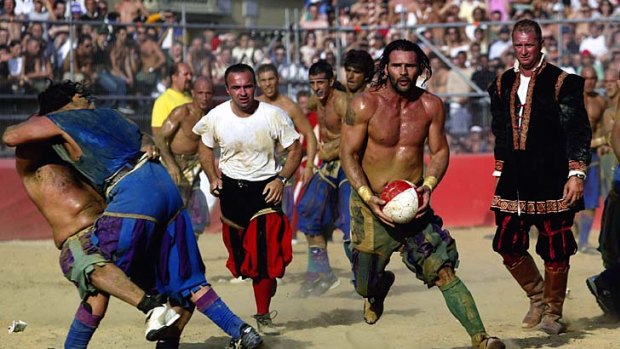
Head to head ... the Verdi team and the Azzurri team in action.Credit: Getty Images
IT'S February 17, 1530 and the city of Florence has been under siege for three months by the army of Holy Roman Emperor Charles V. In an act of defiance, the residents decide to play a soccer match on the embankment of the River Arno in full view of their would-be conquerors. But this is no ordinary soccer match. This is the Calcio Storico - a brutal, bloody, no holds-barred battle between two teams of 27 men. Does it stop the siege? No. The city falls six months later, but the match becomes a piece of folklore celebrated to this day.
Fast forward nearly 500 years and I'm standing in a packed stand watching 54 men beat the living hell out of each other. When I'd heard that the Calcio Storico was still played in Florence each year I presumed it would be a tame re-enactment. But this is the real deal.
Normally, there are three matches - two semi-finals and a final held on June 24, the public holiday for the patron saint of Florence, St John. The matches are played between teams representing the four historic quarters of the city: San Giovanni (the Greens), Santa Maria Novella (Reds), Santa Croce (Blues) and Santo Spirito (Whites).
Before the match, marching bands in mediaeval costume accompany the players as they make their way to the makeshift dirt pitch in the piazza in front of Santa Croce church. A great roar goes up when the two teams enter the ground and start ripping their shirts off and rolling around in the dirt. In years gone by members of the nobility used to take part to show their strength and eligibility and the sudden appearance of dozens of shirtless, quite muscular men certainly seems to have piqued my girlfriend's interest.
The bands leave and the referee - dressed in a red-and-white tunic, baggy pantaloons and a plumed hat - gets the game under way.
Immediately, players lock arms and start grappling in the dirt. I presume someone has the ball but it's hard to tell because the field is a writhing mass of bodies.
Eventually, a player from the Blues emerges from the scrum and sprints down the left flank. And straight into the elbow of an opponent. He goes down with a thump and the crowd goes wild.
I ask the man standing next to me if there are any rules and he explains that the aim is to score a goal by throwing the ball into the opposing team's net, which stretches the width of the field. If it goes in, the team gets a point, if it misses or it's intercepted, the other team gets half a point. The teams switch ends after each goal and there is no half-time during the 50-minute contest. "Like a war," he adds.
Soon the goals start going in and after 30 minutes the Blues lead the Whites 4½-2. A few minutes later the first player is stretchered off and now a team of yellow-shirted medics is patrolling the pitch pouring water over the exhausted men still wrestling on the ground. This is clearly an outlet for settling old scores. One bandanna-wearing player of the Whites spends the entire game pursuing the same weary-looking Blues player.
When the final whistle blows, the Blues have thrashed the Whites 11½-3. The jubilant team are joined by their prize - a white calf - and parade proudly around the ground.
Ironically, it's the same evening Italy is knocked out of the World Cup after one of their worst performances in the championship. Perhaps they should have taken a leaf out of Santa Croce's book and employed a more mediaeval approach.
Sign up for the Traveller Deals newsletter
Get exclusive travel deals delivered straight to your inbox. Sign up now.